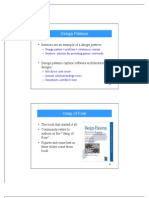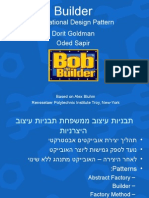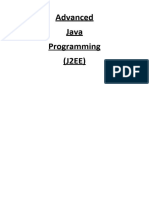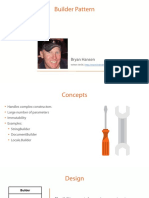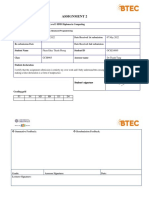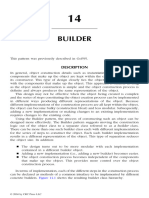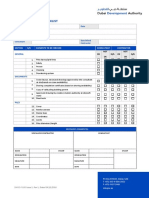Java Interview Series
Shiva Prasad
Gurram
Hi, AMHello,
Jaanu
Q - 1 RR Shiva
GU
AD
AS
PR
VA
HI
S
�What is a Builder
design pattern
A M Great
and why it is so
important? RR question, Let
me explain
GU
AD
AS
PR
VA
HI
S
� Introduction
In the world of software engineering, the ability to design and build
flexible, maintainable, and scalable code is paramount. As
applications grow in complexity, the need for efficient and
Builder pattern comes into play. AM
intuitive object creation becomes evident. This is where the
R R
The Builder pattern is a creational design
G U pattern that enables the
construction of an object from itsA D
construction of complex objects step by step. It separates the
representation, allowing the
same construction process to A S
create different representations.
P R
The pattern encapsulates the logic for constructing an object in a
A
separate builder class, providing a clear and intuitive interface for
object creation. IV
SH
� The Importance of the Builder
Pattern
Enhanced Readability: One of the key advantages of the Builder
A MM
Pattern is its ability to improve code readability. By encapsulating
R RR A
the object construction process within a separate builder class, the
client code becomes more expressive and self-explanatory. The
G UUR
builder class contains methods that represent each step in the
D G
construction process, making the code easier to understand and
A
maintain.
SA D
R AAS
Flexible Object Creation:P
creating objects with A P R
The
varying
Builder Pattern provides flexibility in
configurations. It allows clients to
I V A
selectively set properties
V or provide default values for optional
S H I
parameters, resulting
H in a more customizable object creation
process. This S
flexibility reduces the complexity of object creation
and eliminates the need for multiple constructors or excessive
constructor parameters.
�Encapsulation of Complex Object Construction: In scenarios where
object construction involves intricate steps or complex logic, the
Builder Pattern shines. By encapsulating the construction process
within the builder class, the complexity is abstracted away from the
client code. This promotes a cleaner and more maintainable
A M
codebase, as any changes or updates to the construction process can
be confined to the builder class.
R R
U
G have numerous benefits
Facilitates Immutability: Immutable objects
A D
in software development, such as thread safety, ease of testing, and
A S
prevention of unintended modifications. The Builder Pattern
R
inherently supports the creation of immutable objects by
P step and ensuring the final object is in a
constructing them step by
consistent state. ThisA
IV feature is particularly valuable in concurrent or
SH
multi-threaded environments.
�Highlights of the Builder Pattern
Separates the construction of complex objects from their
representation.
Enhances code readability by encapsulating the object
M
construction process within a builder class.
A
configurations. RR
Provides flexibility in creating objects with varying
GU
Encapsulates complex object construction logic, leading to
D
cleaner and more maintainable code.
A
S
Facilitates the creation of immutable objects, ensuring thread
A
PR
safety and ease of testing.
Reduces the need for multiple constructors or excessive
A
constructor parameters.
V
I
Allows clients to selectively set properties or provide default
SH
values for optional parameters.
Promotes a modular and scalable approach to object creation.
Enables easy changes or updates to the construction process
without affecting client code.
Improves code maintainability and reusability.
� Demonstration
AM
RR
GU
AD
AS
PR
V A
In this example, H
I
S we have a House class that represents a house
object with various properties such as foundation, structure, roof,
and interior. The House class has a private constructor to enforce
object creation through the builder.
�Builder class
AM
RR
GU
AD
AS
PR
VA
I
SH
�The House.Builder class is an inner class within House and serves
as the builder for constructing House objects. It contains methods
for setting each property of the House object, with a chaining
mechanism that allows method calls to be concatenated.
M
Let's see an example usage of the builder to create a House
A
object:
RR
GU
AD
AS
PR
VA
I
SH
�In this usage example, we first create a new instance of the
House.Builder class. Then, we chain the builder's methods to set
the desired property values for the House object. Finally, we call
the build() method to construct the House object using the
configured values.
A M
This implementation allows for flexible objectR creation, as we can
U
selectively set properties and omit optionalR properties if needed.
G
It also promotes code readability by encapsulating the
A D
construction process within the builder class.
A S
objects that have many P
R
The Builder Pattern is particularly useful when dealing with
optional properties or require complex
construction logic. ItA
helps keep the codebase clean, maintainable,
V
and extensible byIseparating the construction process from the
client code. S
H
�How to access previous articles?
1) You can join my Telegram group, where I have uploaded pdf's
of earlier articles.
A M
@dailydsawithspg R
R
G U
A D
2) You can visit my blog, where you can find earlier articles.
A S
P R
https://shivaprasadgurram.hashnode.dev/
VA
I
H more about problem solving and Java by
3) You may Slearn
subscribing to my YouTube channel.
@shivaprasadgurram
� AM
RR
GU
AD
A S
R
For more articles
P like this, follow me.
VA
I
SH
Shiva Prasad Gurram






















